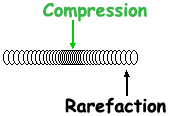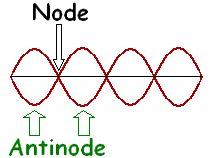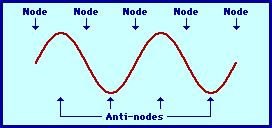 An Introduction to Waves
An Introduction to Waves
Javascripts provided by Rainbow Arch
Wave- disturbance that travels through a medium (matter or space)

Amplitude- height
of a wave
# waves/time (usu. Seconds)
Transverse waves- particles in the medium move perpendicular to the wave
|
How about the stadium wave? We have a wave traveling through |
|
The stadium "wave" travels all around the stadium. That means the
movement of the medium (the people) |
Longitudinal waves-
particles in the medium move in the same direction as the wave
Another great example http://members.aol.com/nicholashl/waves/movingwaves.html
 Animation by Dr. Dan Russell
Animation by Dr. Dan Russell

| Compression- “squeezed
together” area in a compression wave |
 |
| Rarefaction- “Stretched”
area in a compression wave |
What do waves transfer?
Energy
 http://home.pacbell.net/chabpyne/wrecks.html
http://home.pacbell.net/chabpyne/wrecks.html
Reflection- the “bouncing
back” of a wave after striking a barrier
| angle
of incidence – angle between incoming wave & normal |
 |
| a “normal” – a line perpendicular to the reflective surface (barrier) | |
| angle of reflection – angle between outgoing wave & normal |
angle of incidence =
angle of reflection
refraction – change
of direction when a wave enters a different medium
constructive interference
– 2 waves collide and build a bigger wave
destructive interference –
2 waves collide and cancel each other out
standing waves – waves
that have a part that doesn’t move & other
parts with increased amplitude
nodes
– points on a standing wave that have no vibration
antinodes – points on a
standing wave that have increased vibration
|
Report Bad Hyper
Links Here |






